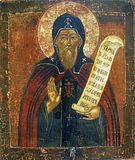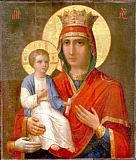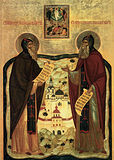

| Previous day | Next day |
| Old Style
June 28
|
Tuesday |
New Style
July 11
|
|
6th Week after Pentecost.
Tone 4.
Fast of the Holy Apostles. |
Fish, wine and oil allowed.
|
![]() Translation of the relics of the Holy Wonderworking Unmercenaries and Martyrs Cyrus and John (412).
Translation of the relics of the Holy Wonderworking Unmercenaries and Martyrs Cyrus and John (412). ![]() Sts. Sergius and Herman, founders and abbots of Valaam (14th c.).
Sts. Sergius and Herman, founders and abbots of Valaam (14th c.).
St. Xenophon, founder of Robeika Monastery (Novgorod) (1262). St. Paul the Physician, of Corinth (7th c.). St. Heliodorus, schema-archimandrite of Glinsk Hermitage (1879).
Icon of the Most Holy Theotokos “Of the Three Hands” of Hilandar, Mt. Athos (8th c.).
St. Senuphius the Standard-bearer, of Egypt (late 4th c.). St. Austell of Cornwall (6th c.). St. Theodichildis (Telchildis), abbess, of Jouarre (Gaul) (ca. 660). St. Sergius the Magistrate, of Paphlagonia, founder of the Nikitiatus Monastery in Nicomedia (866). St. Sophrony (Sakharov) of Essex (1993).
Repose of Archimandrite Methodius (Popovich) of Jerusalem (1997).
Thoughts for Each Day of the Year
According to the Daily Church Readings from the Word of God
By St. Theophan the Recluse

Wednesday. [I Cor. 2:9-3:8; Matt. 13:31-36]
The kingdom is like a grain of mustard seed and leaven. A small grain of mustard seed grows up into a big bush; leaven penetrates the whole lump of dough and makes it leavened. Here, on the one hand, is an image for the Church, which in the beginning consisted only of the apostles and several other people, then spread and became most numerous, penetrating all of humanity; on the other hand, it is an image of the spiritual life revealed in every person. Its first seed is the intention and determination to be saved through pleasing God, upon faith in the Lord and Saviour. This determination, no matter how firm, is like a tiny dot. In the beginning it embraces only one’s consciousness and activities; then from this all of the activity of a spiritual life develops. Its movement and strength multiply and mature within its own self, and it begins to penetrate all the powers of the soul—the mind, will, feelings, then fills them with itself, makes them leavened according to its spirit, and penetrates the entire constitution of the human nature, body, soul, and spirit in which it was engendered.
Tuesday. [I Cor. 1:1-9; Matt. 13:24-30]
The good seed was sown, but the enemy came and sowed tares among the wheat. The tares in the Church are heresies and schisms, and in each of us they are bad thoughts, feelings, desires, and passions. A person accepts the good seed of the word of God, decides to live in a holy way, and begins to live in this way. When such a person falls asleep, that is, when his attention toward himself weakens, then the enemy of salvation comes and places evil ideas in him, which if not rejected at the start ripen into desires and dispositions, introducing their own spheres of activity, which mix themselves in with good deeds, feelings and thoughts. Both remain together this way until the harvest. This harvest is repentance. The Lord sends the angels—a feeling of contrition and the fear of God, and they come in like a sickle, then burn up all the tares in a fire of painful self-condemnation. Pure wheat remains in the grain-house of the heart, to the joy of the man, the angels, and the most Good God worshipped in the Trinity.
Articles
 Wonderworker and Unmercenary CyrusSaint Cyrus was a noted physician in the city of Alexandria, where he had been born and raised. |
 Venerable Sergius the Wonderworker of ValaamSaints Sergius and Herman settled on the island of Valaam in 1329. |
 Venerable Herman the Wonderworker of ValaamSaints Sergius and Herman settled on the island of Valaam in 1329. The brethren gathered by them spread the light of Orthodoxy in this frontier land. |
 Venerable Xenophon the Abbot of Robeika, NovgorodSaint Xenophon of Robeika was a student of St. Barlaam of Khutyn. |







